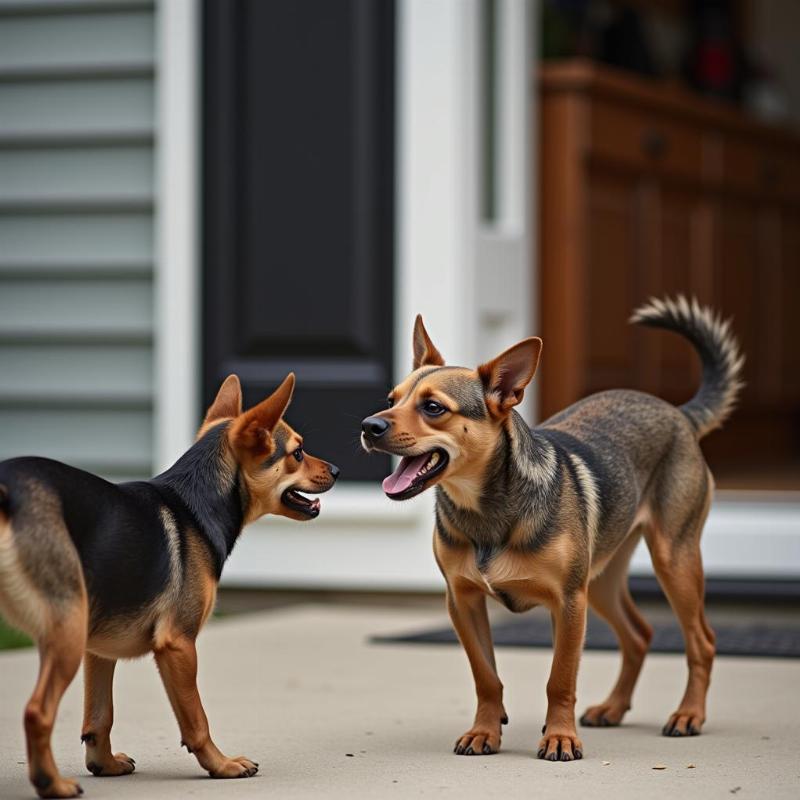“What did one dog say to the other dog?” is a question often posed as a setup for a joke. While dogs communicate through body language, barks, whines, and growls, they don’t engage in verbal conversations like humans. This question sparks our imagination about the secret lives of our canine companions and opens up a world of humorous possibilities. Let’s explore the fun and creativity behind this simple question and delve into how dogs actually communicate with each other and us.
From Jokes to Real Communication: Decoding Canine Language
The beauty of “What did one dog say to the other dog?” lies in its open-ended nature. The answer can be anything from a pun-filled canine quip to a profound observation about dog life. This question encourages playful interaction and provides an opportunity to imagine the inner world of our furry friends. While we may never truly know what dogs “say” to each other, we can learn to understand their real communication methods.
Understanding Dog Body Language
Dogs rely heavily on body language to communicate. A wagging tail doesn’t always indicate happiness; the speed, direction, and position of the tail can convey a range of emotions from excitement to anxiety. Similarly, ear position, posture, and facial expressions play crucial roles in their communication. For example, a dog with its ears back and body lowered may be showing signs of fear or submission. Understanding these subtle cues can help us better interpret our dog’s feelings and intentions.
Vocalizations: Barks, Whines, and Growls
Vocalizations are another key component of dog communication. Barks can signal a variety of things, including alertness, excitement, or territoriality. Whines often indicate discomfort or a need for attention, while growls can be a warning sign of aggression or fear. Paying attention to the context of these vocalizations, along with the accompanying body language, is essential for accurate interpretation.
 Dog barking at a delivery person
Dog barking at a delivery person
Why We Love to Anthropomorphize Our Dogs
Attributing human characteristics to animals, known as anthropomorphism, is a common human tendency. We love to imagine our dogs having conversations, experiencing complex emotions, and even telling jokes. This reflects the deep bond we share with our pets and our desire to understand their world. While it’s important to remember that dogs don’t think and communicate exactly like humans, a little anthropomorphism can add to the joy of pet ownership.
The Humor in “Dog Speak”
“What did one dog say to the other dog?” invites us to create humorous scenarios and invent witty canine dialogue. The absurdity of imagining dogs discussing politics, sharing gossip, or making puns adds to the comedic appeal. This playful approach allows us to connect with our dogs on a different level and appreciate their unique personalities.
Tips for Effective Communication with Your Dog
While dogs may not understand our words in the same way we do, they are highly attuned to our tone of voice, body language, and facial expressions. Building a strong relationship with your dog requires clear and consistent communication.
- Positive Reinforcement: Use positive reinforcement techniques such as praise, treats, and toys to reward desired behaviors.
- Clear and Consistent Commands: Use short, clear commands and maintain consistency in your training.
- Body Language Awareness: Be mindful of your own body language and ensure it aligns with your verbal communication.
- Patience and Understanding: Remember that dogs learn at different paces. Be patient and understanding throughout the training process.
Conclusion
“What did one dog say to the other dog?” may be a simple question, but it opens up a world of imagination and humor. While dogs don’t communicate with words like humans, they have a rich and complex language of their own. By learning to understand their body language, vocalizations, and individual personalities, we can strengthen our bond with our canine companions and appreciate the unique joy they bring to our lives. Understanding their communication helps us become better pet parents and ensures a happy and harmonious relationship with our furry friends.
FAQ
- Do dogs understand human language? While dogs don’t understand the meaning of every word, they are incredibly adept at picking up on our tone of voice, body language, and facial expressions.
- How can I improve communication with my dog? Use positive reinforcement, clear and consistent commands, be aware of your own body language, and practice patience.
- What are the most common signs of dog body language? Wagging tail (various meanings depending on position and speed), ear position, posture, and facial expressions.
- What do different types of dog barks mean? Barks can signal alertness, excitement, fear, territoriality, or a need for attention. Context is key.
- Why do dogs whine? Whining can indicate discomfort, pain, anxiety, or a desire for something like food, water, or attention.
Related Articles on Beautdogs.us
- cards for loss of dog
- best small dog breeds for hiking
- dog friendly places key west
- my dog swallowed a popsicle stick
- necklace for dog that passed away
About Beautdogs.us
Beautdogs.us is your premier online resource for all things dog-related in the United States. From breed information and expert grooming tips to valuable insights on dog health and behavior, we provide comprehensive and trustworthy information for both new and experienced dog owners. We also offer a curated selection of products and services tailored to the American dog lover. Contact us for more information at [email protected] or call us at +1 501-555-7529.